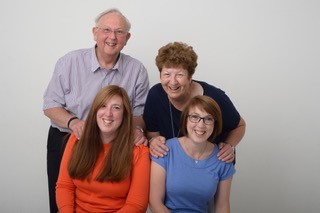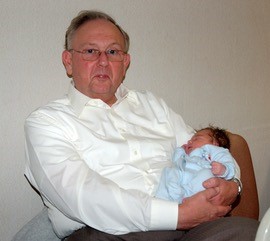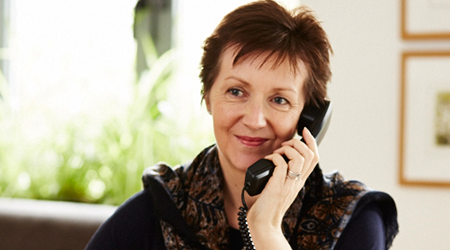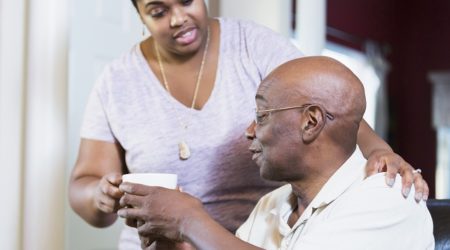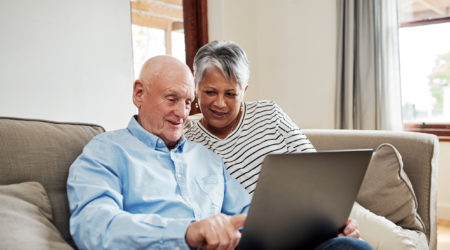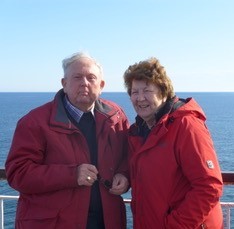
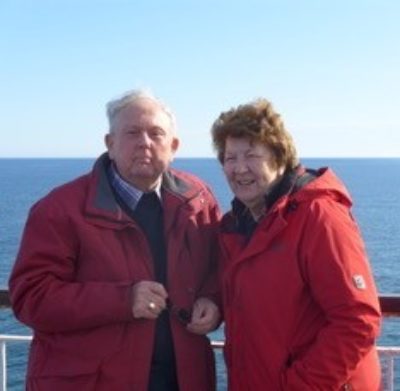
Clive
Clive was 74 years old when his daughter noticed he had symptoms of jaundice. After a number of tests, several rounds of chemotherapy and radiotherapy, he was able to have the cancer removed by a Whipple’s procedure. He is recovering well and talks about his experience to help others who are being diagnosed.
Where do I start, I suppose like any journey, for that is what it is, at the beginning.
July 2021, a normal Saturday until my daughter arrived and exclaimed, “Dad, you’re yellow!” I had been feeling a bit off for a couple of weeks, itchy skin and dark pee. At first, I put it down to hot weather and dehydration. I had already realised all was not OK and had contacted my GP by phone, who ordered blood tests.
I was completely ignorant about pancreatic cancer symptoms and looking back I was like a rabbit in the headlights.
Clive with his family.
Starting the journey to a diagnosis
A Saturday morning visit to my local A&E followed, and I was admitted. I had a CT scan on the Sunday and again on the Monday. Then the bombshell, to be told it was a tumour in the pancreas which had caused a blocked bile duct. A stent was fitted on the Tuesday to allow the jaundice to clear, then home the following day to let it all sink in. I was referred to the local pancreatic specialist centre.
The worst part was telling my family and it is an understatement to say it was a shock, all sorts of scenarios played out in my mind.
Deciding my treatment options was a roller coaster
Then the pace picked up. Assessment, more scans, and a decision that it was operable, but I would have to go to London for the surgery.
Then, silence, until a letter arrived with an appointment to see the lead consultant at my regional cancer centre. I was told the tumour was attached to the portal vein, and it was inoperable. Oncology (chemotherapy) was my only hope.
I was referred to the local regional oncology centre. I had been warned by the surgeon that chemotherapy had a very low success rate, but the specialist nurse, oncology staff and Pancreatic Cancer UK nurses were much more upbeat about that. The plan was to have chemotherapy and radiotherapy first, and then hopefully be able to have surgery.
Talk about a roller coaster ride!
I needed help and support
At that point I felt very alone and lost, I needed help, support, and advice. I rang Pancreatic Cancer UK and spoke to a specialist nurse. That was the turning point, she reassured me that chemotherapy was the best option and to get a second opinion, which I did.
Getting a second opinion – and starting treatment
A request went to the hospital in London I had originally been asked about. The reply came back agreeing with the first opinion that surgery was not viable, and oncology (chemotherapy) was the best route.
Next, chemotherapy. I had a very positive feel to the first consultation. I was referred to get a PICC line fitted and flu jab, blood tests, everything moved very quickly. I’ll never forget the consultant oncologist saying, “You are fit, with no underlying health conditions. I am going to throw all I have at you, and look out, the kitchen sink is coming after it.”
Seven cycles of FOLFIRINOX followed over fifteen weeks, delivered at my local hospital, with a follow up call from the oncology team after each, to check side effects and tweak the dosage.
My chemotherapy routine
I did experience side effects, especially after the first session. I told the oncology team about these on the first call back, all had been forewarned, but they were not severe for me.
I told the oncology team about the side effects on the first call back and that, coupled with a low blood count, meant that they delayed my next session for a week and reduced the dosage by 15%. The side effects were well controlled from then and the medication for them worked well.
I was able to deal with the side effects of chemotherapy
I am not going to go through them all, just the main ones.
- Fatigue – I just had to give in and rest and grab sleep when I could.
- Nausea (feeling sick) – usually on days 1, 2, 3, and 4 of the chemotherapy cycle, but not severe.
- Diarrhoea (runny poo) – usually days 5 and 6 of the cycle, mainly loose stools but I used the medication provided.
- Sore mouth – I found Corsodyl mouthwash and Bonjela helped.
- Loss of sensation in my hands and feet – I was very sensitive to the cold and kept dropping things. I used gloves to handle cold items and outside in cold weather. It is wearing off now after 11 months and I can hold a pen and write, use a keyboard, and do up shirt buttons! This was one of the most frustrating things, but I’ve even gone back to piano practice (you notice I use the word practice, not play, I am not that good yet!).
- Also the thinning hair, which started after the first session. Not that I had that much to start with!
How the chemotherapy was given
I settled into the 14-day routine.
The PICC line saved the continued use of needles, which helped as my veins are not easy to find at the best of times. I left each time with a pump to continue the infusion at home. It was not easy to sleep with that fitted, but the steroids to help with the feeling of sickness meant I was like a Duracell Bunny anyway! Sleep was not easy until those wore off.
Community nurses visited to flush the PICC line and do bloods and COVID tests before the next round started. My haemoglobin (iron levels) went down a couple of times, even needing a transfusion during radiotherapy, which came next.
Getting some good news – and more treatment
After six cycles the tumour had stopped growing. A seventh cycle was ordered, followed by fifteen sessions of combined radiotherapy and chemotherapy to shrink it.
I met with the oncology consultant, who told me that in his opinion the tumour was now operable, the term ‘borderline resectable’ was used. He referred me back to the pancreatic specialist consultant surgeon, who agreed surgery to remove the cancer was an option, and referred me to the hospital in London.
Waiting for surgery to remove the cancer
A date for my admission to hospital was fixed (July 1st). But unfortunately, I had a positive COVID test three days before admission. I had to wait for a negative result and was admitted less than two weeks later.
Having the Whipple’s operation
I remember nothing of my early recovery. I woke up full of tubes, drains, pipes and bleeping monitors but not in pain. The post-anaesthetic hallucinations were interesting, but I was prepared for those, and they wore off quickly.
The highlight was the consultant surgeon telling me the procedure, had been a complete success. When he got to the tumour, 90% of it was dead, killed by the chemoradiotherapy. His opinion was that no further treatment was required. They would follow up and refer me back to my regional oncology centre.
Recovering from the surgery
I was in the hospital in London for three weeks, as an infection had developed. That kept me there longer than normal for this operation.
I missed my family back in Wales, but the hospital Wi-Fi was great and things like FaceTime and WhatsApp video helped me to keep in touch. Once I was mobile, I walked every day down to the shop or outside. That helped a lot, different scenery and some exercise. Finally, home early August and relax, get some sleep and recover.
I am still being well cared for by the NHS medical team
I had follow ups from dietitians and the surgical team in early September, they discharged me back to Oncology. The consultant there agreed I need no further chemo at present, but it is there if I need it.
I will be monitored every three months for the next two years.
Getting used to life after pancreatic cancer
I had to take it easy for twelve weeks, I felt some aching but no real pain. I really missed driving, but I’m back on the road 6 weeks post-op, locally, no long distances yet.
The main change has been my diet and food. I eat smaller meals, with ‘Creon’ by my side. I take between six and ten capsules at every meal and three for snacks, which seems to work. I vary the dose in line with what I am eating, at home that’s not a problem but judging food when eating out is more problematic and difficult to allow for. When I first saw the surgeons in August 2021, they put me on Creon early and warned me that I should aim to not lose weight. Overall, I have lost about 20kg, but after advice from dietitians it has stabilised. I weigh myself weekly and adjust the Creon dose and my food intake to keep it stable.
I am back to enjoying life again
At the time of writing this I am over 5 months post-op and feeling well, in fact better than I have done for years. I am told a full recovery from surgery takes up to 12 months.
My outlook has changed, I look forward to each day and time with the family. I’m looking forward to a holiday after the twelve months post-surgery date. I’m already planning that and a family celebration, something I did not allow myself to do not so long ago.
I took some ribbing from the family about looking like a yellow minion when I was diagnosed and when my hair started to grow back, it formed a Mohican style for a while! With that and the tattoos (three dots for the radiotherapy) and a piercing where the PICC line was fitted, they said I was very ‘with it’ at my age.
I have met some amazing people along the way on this journey. The support I have received has been exceptional, especially NHS staff of all specialities and grades and the Pancreatic Cancer UK specialist nurses, but also Macmillan Cancer Support and the hospital chaplains.
I do not know what is in store for me, it’s like being on a train, people get on and off. The only difference is, I do not know the length of the journey or its destination, so all I can do is enjoy the ride. I hope in reading this you can see it is a journey, and the power for that journey is positivity and trust, and sometimes saying to yourself “I will control what I can control. I have cancer, cancer does not have me.”
Good luck with your journey.
Clive
January 2023
